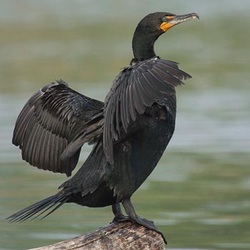Benefits

Figure 9: Double-crested Cormorant [6].
Benefits take many forms, including creation of wildlife habitat and recreation opportunities. The Arcata marsh and Wildlife Sanctuary now contains 307 acres of marshes, mudflats, and grasslands along the Bay.
Wildlife Habitat: There are over 270 species of birds through out the year. Seasonal migratory birds use the wetland area to breed [9]. Birds that can be seen throughout the year include: loons, grebes, pelicans, cormorants, bitterns, herons, egrets, geese, ducks, vultures, hawks, flacons, quails, rails, stilts and shorebirds, jaegers, gulls, terns, auks, doves, owls, goatsuckers, swifts, hummingbirds, kingfishers, woodpeckers, flycatchers, larks, swallows, jays, crows, ravens, plovers, chickadees, bushtits, nuthatches, creepers, wrens, kinglets, thrushes, mockingbirds, pipits, waxwings, shrikes, starlings, vireos, warblers, tanagers, grosbeaks, sparrows, buntings, meadowlarks, blackbirds, orioles, and finishes.
Wildlife Habitat: There are over 270 species of birds through out the year. Seasonal migratory birds use the wetland area to breed [9]. Birds that can be seen throughout the year include: loons, grebes, pelicans, cormorants, bitterns, herons, egrets, geese, ducks, vultures, hawks, flacons, quails, rails, stilts and shorebirds, jaegers, gulls, terns, auks, doves, owls, goatsuckers, swifts, hummingbirds, kingfishers, woodpeckers, flycatchers, larks, swallows, jays, crows, ravens, plovers, chickadees, bushtits, nuthatches, creepers, wrens, kinglets, thrushes, mockingbirds, pipits, waxwings, shrikes, starlings, vireos, warblers, tanagers, grosbeaks, sparrows, buntings, meadowlarks, blackbirds, orioles, and finishes.
Recreation: There are 4.66 miles of trails for recreational use as well as an Interpretive Center, which receives over 150,000 visitors per year. Trails are used heavily for jogging, biking, hiking, and bird watching. Much of the current restoration activities at the site focus on the removal of non-native invasive species by volunteers. Ongoing restoration work also includes expansion by 75 acres of marsh.

